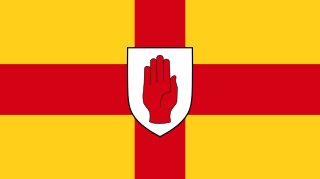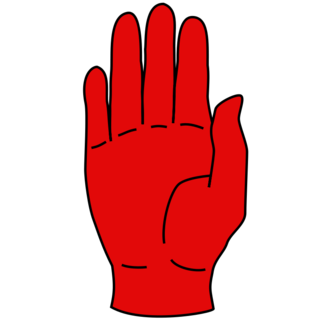
Northern Ireland is a part of the United Kingdom that is variously described as a country, province, territory or region. Located in the northeast of the island of Ireland, Northern Ireland shares a border to the south and west with the Republic of Ireland. In 2011, its population was 1,810,863, constituting about 30% of the island's population and about 3% of the UK's population. The Northern Ireland Assembly, established by the Northern Ireland Act 1998, holds responsibility for a range of devolved policy matters, while other areas are reserved for the British government. Northern Ireland co-operates with the Republic of Ireland in several areas.

Ulster is one of the four traditional Irish provinces, in the north of Ireland. It is made up of nine counties: six of these constitute Northern Ireland ; the remaining three are in the Republic of Ireland.

The Ulster Volunteer Force (UVF) is an Ulster loyalist paramilitary group. Formed in 1965, it first emerged in 1966. Its first leader was Gusty Spence, a former British Army soldier from Northern Ireland. The group undertook an armed campaign of almost thirty years during The Troubles. It declared a ceasefire in 1994 and officially ended its campaign in 2007, although some of its members have continued to engage in violence and criminal activities. The group is classified as a terrorist organisation by the United Kingdom and Republic of Ireland.

The only official flag in Northern Ireland is the Union Flag of the United Kingdom. The flying of various flags in Northern Ireland is a significant sectarian issue, with different communities identifying with different flags.

The Irish Rugby Football Union (IRFU) is the body managing rugby union in the island of Ireland. The IRFU has its head office at 10/12 Lansdowne Road and home ground at Aviva Stadium, where adult men's Irish rugby union international matches are played. In addition, the Union also owns the Ravenhill Stadium in Belfast, Thomond Park in Limerick and a number of grounds in provincial areas that have been rented to clubs.

The culture of Northern Ireland relates to the traditions of Northern Ireland. Elements of the Culture of Ulster and the Culture of the United Kingdom are to be found.

The coat of arms of Ireland is blazoned as Azure a harp Or, stringed Argent. These arms have long been Ireland's heraldic emblem. References to them as being the arms of the king of Ireland can be found as early as the 13th century. These arms were adopted by Henry VIII of England when he ended the period of Lordship of Ireland and declared Ireland to be a kingdom again in 1541. When the crowns of England, Scotland and Ireland were united in 1603, they were integrated into the unified royal coat of arms of kingdoms of England, Scotland and Ireland. The harp was adopted as the emblem of the Irish Free State when it separated from the United Kingdom in 1922. They were registered as the arms of Ireland with the Chief Herald of Ireland on 9 November 1945.

Ulster English is the variety of English spoken in most of the Irish province of Ulster and throughout Northern Ireland. The dialect has been influenced by the Ulster Irish and Scots languages, the latter of which was brought over by Scottish settlers during the Plantation of Ulster and subsequent settlements throughout the 17th and 18th centuries.

The Twelfth is an Ulster Protestant celebration held on 12 July. It began in the late 18th century in Ulster. It celebrates the Glorious Revolution (1688) and victory of Protestant King William of Orange over Catholic King James II at the Battle of the Boyne (1690), which ensured a Protestant Ascendancy in Ireland. On and around the Twelfth, large parades are held by the Orange Order and Ulster loyalist marching bands, streets are bedecked with British flags and bunting, and large towering bonfires are lit in loyalist neighbourhoods. Today the Twelfth is mainly celebrated in Northern Ireland, where it is a public holiday, but smaller celebrations are held in other countries where Orange lodges have been set up.

The flag of Ulster is a historic banner based on the coat of arms of Ulster, used to represent Ulster, one of the four provinces of Ireland. It consists of a red cross on a gold background with a red hand on a white shield in the centre.

The Ulster Banner, also known as the Flag of Northern Ireland, is a heraldic banner taken from the former Coat of Arms of Northern Ireland, consisting of a red cross on a white field, upon which is a crowned six-pointed star with a red hand in the centre. It was the flag of the former Government of Northern Ireland and common flag of Northern Ireland from 1953 until that government was abolished in 1972.

Ulster loyalism is a strand of Ulster unionism associated with working class Ulster Protestants in Northern Ireland. Like unionists, loyalists support the continued existence of Northern Ireland within the United Kingdom, and oppose a united Ireland. Unlike other strands of unionism, loyalism has been described as an ethnic nationalism of Ulster Protestants and "a variation of British nationalism". Loyalists are often said to have a conditional loyalty to the British state so long as it defends their interests. They see themselves as loyal primarily to the Protestant British monarchy rather than to British governments and institutions, while Garret FitzGerald argued they are loyal to 'Ulster' over 'the Union'. A small minority of loyalists have called for an independent Ulster Protestant state, believing they cannot rely on British governments to support them. The term 'loyalism' is usually associated with paramilitarism.
The Northern Ireland flags issue is one that divides the population along sectarian lines. Depending on political allegiance, people identify with differing flags and symbols, some of which have, or have had, official status in Northern Ireland.
William Frederick Frazer was a Northern Irish Ulster loyalist activist and advocate for those affected by Irish republican violence in Northern Ireland. He was the founder and leader of the pressure group Families Acting for Innocent Relatives (FAIR). He was also a leader of the Love Ulster campaign and more recently, the Belfast City Hall flag protests. In 2019, from evidence gained in a police report, journalist Mandy McAuley asserted that the Ulster Defence Association had been supplied weapons, in the late 1980s, by the Ulster Resistance and that Frazer was the point of contact for those supplies. She asserted that multiple sources also confirmed this to be true. Those weapons were linked to at least 70 paramilitary murders.

The Red Hand of Ulster is a symbol used in heraldry to denote the Irish province of Ulster in particular, although historically the hand has been used by many Irish clans across the island, including the ruling families of western Connacht and the chiefs of the Midlands.

Northern Ireland has competed in eighteen of the twenty Commonwealth Games beginning with the second games, held in 1934. Northern Ireland did not compete in 1930 and in 1950. It differs from the Olympic Games where although it officially competes with England, Scotland and Wales as part of Great Britain and Northern Ireland, many athletes have represented the Ireland team.
Northern Irish people is a demonym for all people born in Northern Ireland or people who are entitled to reside in Northern Ireland without any restriction on their period of residence. Most Northern Irish people either identify as Northern Irish, Irish or British, or a combination thereof.

A by-election for the UK House of Commons constituency of Mid Ulster in Northern Ireland was held on 7 March 2013. The election was triggered by the resignation of Martin McGuinness, who had been elected to the seat in 1997 as the Sinn Féin candidate. The election was won by Francie Molloy, also of Sinn Féin.

The national flag of Ireland, frequently referred to in Ireland as 'the tricolour' and elsewhere as the Irish tricolour is a vertical tricolour of green, white and orange. The proportions of the flag are 1:2.













